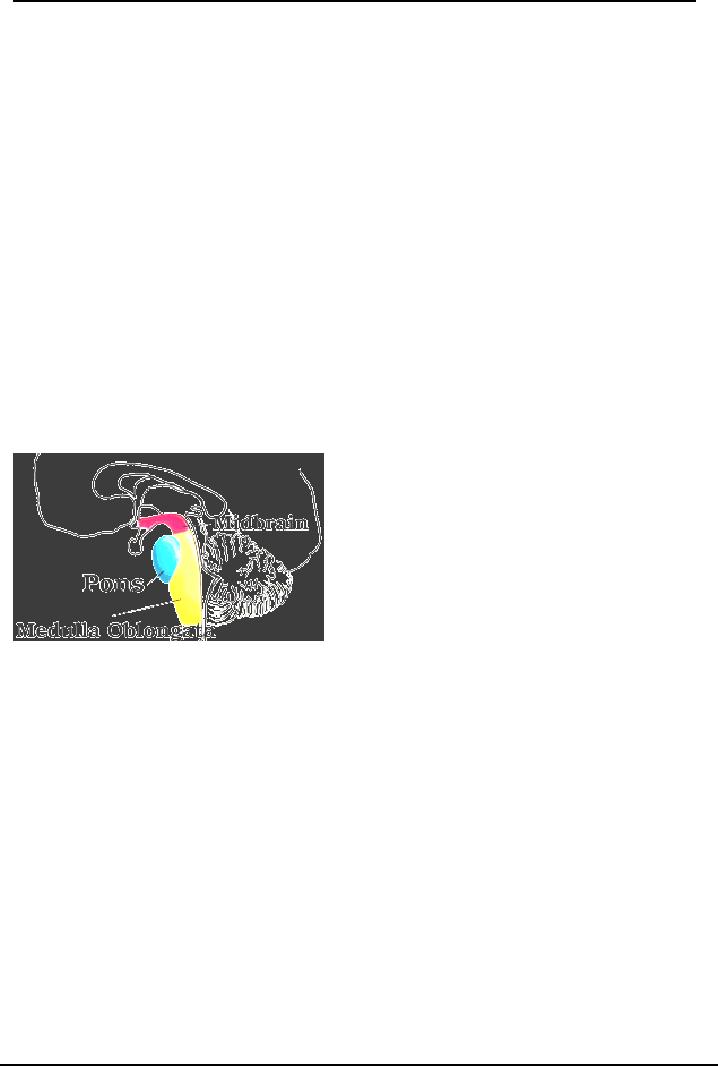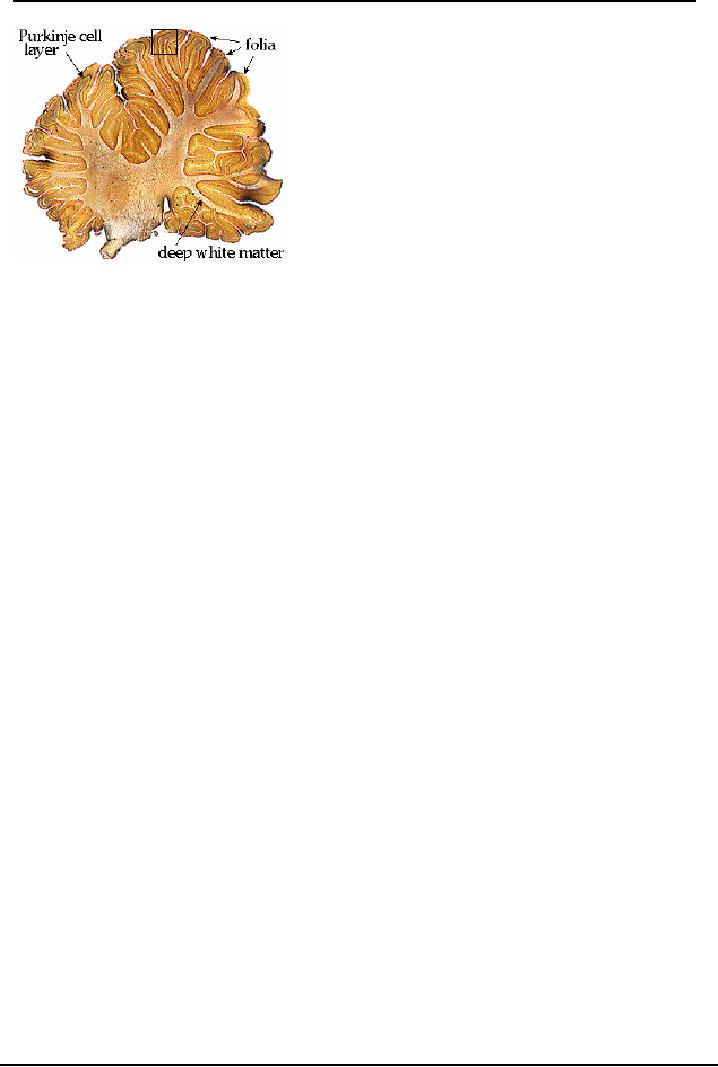 |

Neurological
Basis of Behavior (PSY -
610)
VU
Lesson27
Basic
Neuroanatomy
Objectives:
The
main objective of this lesson is to study
�
The
Brain and the Peripheral systems:
�
Brain:
Forebrain, Mid brain, Hind Brain functioning of each anatomical location in the
CNS.
Starting
from the posterior located areas upto the anterior-most.
�
Cerebral
Cortex: its layers, Corpus Callosum and the two hemispheres
Main
purpose:
Students
will become familiarized
with the location of various
brain areas, their functions
and their
relationship
to other areas. The students
would also understand how
control and modulation of
behaviour
related to each neuroanatomical site
takes place
Basic
Neuroanatomy is based on the following assumptions:
�
The
cortex is newly evolved as compared to the other structures, and it controls all
major
functions
(especially in the higher animals)
�
The
higher areas cover the lower
areas as they have grown
over these areas. The
lower brain
areas
have to send information to the higher
areas and then the commands
for actions come
back
from these areas ( the thalamus
send all messages it
receives to the relevant cortices
and
receives
commands)
�
The
lower underlying areas are
more primitive in terms of functions,
their functions are
more
survival
functions ( the brain stem
areas)
�
These
lower areas are similar in
locations, site and functions in lower
and higher order animals
(e.g.
the hypothalamus, the thalamus).
Phylogenetically,
encephalization (control of the higher
brain areas) has occurred
leading to increased
ability
to interact and respond to the
environment (greater
adaptability).
The
greater the encephalization, the more the functions
are controlled by the higher
brain areas,
therefore
if these areas are damaged
the animals cannot function at a normal
level (Bridgeman,
1988,
Thompson
1980).
The
following would elaborate how the
brain is located with reference to the
spinal cord and how
other
areas
within the brain and the top of the
spinal cord
Brain------------------------------------------------------------------------------spinal
cord
There
are three major divisions of the brain: The Forebrain, the
midbrain and the hind brain.
�
The
Forebrain comprises of the
Telencephalon (coritcal and some subcortical structures) and
Diencephalon
(the Thalamus and the hypothalamus).
�
The
Mid brain consists of older
structures, the Mesencephalon and
�
The
Hind brain The posterior most part
of the brain is called the Hind brain, which has two
sections
the Metencephalon and the Myelencephalon
We
will elaborate these areas further moving from the frontal and dorsal areas to
the more caudal
ventral
areas. The anterior most and the dorsal area is the Telencephalon, with
Myelencephalon at the
caudal
most end
93

Neurological
Basis of Behavior (PSY -
610)
VU
Telencephalon:
comprises
of the Cerebral Cortex, the Corpus Striatum, Cingulate Gyrus,
Septum,
Amygdala,
Hippocampus (these last three are also part of the limbic system). Therefore
this is cerebral
cortex
which is a phylogenetically a newer structure, and some older primitive
structures which underlie
the
cerebral cortex
Diencephalon:
Comprises
of the Thalamus which is the junction and the gateway for all
sensory-motor
and
association pathways and the Hypothalamus which is the primitive survival
centre
Mesencephalon:
has
the Tectum which comprises of the Inferior (for auditory systems) and
the
Superior
colliculi (for visual system) Tegmentum, cerebral peduncles Metencephalon:
comprises of the
Cerebellum
which lies dorsally over the Pons, and the Pons
Myelencephalon
comprises
of the Medulla Oblangata
Brain
stem: includes the
Mesencephalon, Metencephalon and the Myelencephalon i.e.
technically
everything
between spinal cord and cerebral cortex
Myelencephalon:
Medulla
Oblongata ( Oblong and narrow structure) is continuation of spinal cord
and
the
caudal part of the brain stem .Another important structure which is located in
the Brain stem are is
the
reticular formation.
Medulla
contains all the acending and descending fibre
pathways connecting the brain and the
spinal
cord.
It also has nuclei for the
cranial nerves especially
related to the control of respiration;
heart and
digestive
activity enter the brain at the level of
medulla. Cranial nerves for
tongue, larynx, pharynx,
ear,
vestibular,
involved in control of breathing
while sleeping (sleep
apnea), sneezing,
swallowing,
vomiting
are also found
here.
Cranial
nerves:
Hypoglossal
nerve (tongue) -
Cranial
Nerve XII
Accessory
(larynx, voice, mouth mastoid)
Cranial nerve XI
Vagus
(taste, larynx, pharynx,
ear)
Cranial
Nerve X
Glossopharyngeal
(Taste, posterior part of the
Tongue) Cranial IX
Vestibulocochlear
related to ear and
vestibular
Cranial
VIII
Sneezing:
when nasal mucosa is
irritated. The sneezing
center is located in the medial part of
medulla (it
also
involves the trigeminal
nerve).
Vomiting
is found in the Medullar Reticular
Formation
94

Neurological
Basis of Behavior (PSY -
610)
VU
Reticular
Formation: this is a
criss cross of nerve fibres
, nuclei and cell bodies ( like a net (
reticulum
means:
the net). It extends from the
spinal cord to the Thalamus. It is a phylogenetically
older structure.
It
is a well organized are with
both efferent and afferent
ascending and descending fibres:
Ascending
fibres go to thalamus, cortex, and are
involved in sleep and awakening.
Raphe Nuclei
produces
serotonin and extends from the
lower pons, andmedulla.
Analgesia is produced by the
electrical
stimulation of the Periaquaductal greay
(PAG), is through the Raphe
nuclei. It gets input
from
cerebral
cortex, the cerebellum and
output to cerebellum and the spinal
cord. "The reticular
activating
system"
(RAS) which is important in arousal.
Sleep, arousal, muscle tone, alertness
was found to be
located
here by experiments of Moruzzi and Magoun
(1949) on cats. They
stimulated the raphe Nuclei
of
a sleeping cat which led to
an arousal EEG response (low
voltage, high frequency theta
response), it
woke
up, and when the awake cat
was stimulated and it became more
alert. However, when this
area
was
lessioned animals went into a comatose
stuporous state.
Destruction
of the Raphe Nuclei led to
Insomniac cats thus it was
found that the RAS is
important in
sleep
and attention.
Metencephalon.
Has
many tracts going up and down,and contains two important brain areas
the
Cerebellum
and the POns.
Cerebellum:
lies
over Pons, it is a phylogenetically older structure, for sensory motor
coordination,
movement
and balance. It has two lobes like the CC with a large number of lobules
separated by
fissures
( vermis, smaller grooves) with a large number of convulations, but these are
similar all over
(unlike
the cerebral cortex in which there is a difference). The nerve cell layer is 2mm
thick below
which
lies the white matter under which lies the cerebellar nuclei
Cerebellum
receives inputs from the vestibular system, auditory and visual system,
reticular formation,
and
various regions of the cerebral cortex. It sends out fibers to the reticular
formation, thalamus and the
vestibular
system
Damage
to the cerebellum leads to disturbances of gait in all regions. If one lobe is
damaged then there
is
postural imbalance. If both cerebellar poles are damaged there is tendency to
fall backwards because
of
the inability to maintain upright postures and gait disturbance with damage to
the posterior region
In
Humans, Ataxia, characterized by unsteadiness of gait is seen, this is with
anterior lobe syndrome:
with
the following symptoms:
�
Abnormalities
in force, rate, and direction of rapid movements a) overshooting while
reaching
targets
b) jerky not smooth movements. Damage to the cerebellum impairs standing,
walking
and
performance of coordinated movements
�
Birds
and reptiles have large cerebellums? Why?? To maintain balance during flight and
since
sensory
motor fibers are coming and going out to various areas, coordination of
smooth
movements
takes place in this area.
The
oculomotor signs of cerebellar damage are: Nystagamus (rythmic and involuntary
oscillatory
movements
of the eyes)
Cerebellectomy
(removal of the cerebellum) lead to inability to maintain gaze, defective smooth
pursuit
movements,
difficulty of fixation
95

Neurological
Basis of Behavior (PSY -
610)
VU
Cerebellar
neurons: Purkinje cells (long dendritic
trees), Basket cells (short axons, dendrites
cover
Purkinje
cells), Stellate Cells (axons
terminate on Purkinje cells),
granule cells (smallest, go
vertical
for
communication)
Pons:
Bridge
between the medulla, midbrain, and the cerebellum. The medulla is caudally
located
with
refernce to POns and the midbrain is rostrally located. The Dorsal surface of
PONS is covered
by
the cerebellum. Large rounded pontine nuclei contain ascending and descending
fibre bundles.
One
such bundle connects the rbain stem and the cerebellum and contains the
Pyramidal fibres from
Cerebral
cortex to the spinal cord (part of the cortico-spinal tract). The Trigeminal
cranial nerve
enters
and leaves the brain at the level of POns. Further the Cranial nerves for
feeding, facial
expression,
respiratory nuclei, relay nerves for auditory systems are also located
here.
The
cortico-ponto-cerebellar tract is the largest group of fibres which originate
form a wide area of
the
cerebral cortex 9 has over 19 million fibres on each side). These rises from the
primary cortical
areas
are involved in rapid correction of movements.
PONTINE
NUCLEI, THE GIANT PONTINE CELLS play an important role in
rapid eye
movement
sleep by inhibiting the movement of body muscles to prevent damage which could
occur
due
to activation of the body (as the brain is active)
Mesencephalon
is
a small portion between the hind brain and the diencephalons- the
anterior
section
of the brain stem, it is tubular in form. It has three main areas: tectum,
tegmentum, and basis
pedunculi
Tectum
comprises of two pairs of relay nuclei, which look like 4 little lumps on the
surface of the
brain
stem. These are the Superior Colliculi and the Inferior
Colliculi
Superior
Colliculi: laminated grey and white matter important in visual reflexes and eye
movement,
well
defined and organized in terms of receptive fields and maps of visual space. It
is part of the
pathway
coming from the optic tract to the visual cortex for eye movement and gross
spatial
localization.
This is important for vertical gaze and pupillary reflexes. It receives inputs
from retina
of
eyes, thalamus, and inferior colliculus and sends outputs to thalamus and
frontal and visual
cortices.
Inferior
colliculi: it is an oval mass of small and medium sized neurons and is major
relay nuclei for
the
auditory pathway. Fibres come in from the Thalamus (Medial Geniculate Nuclei),
auditory
cortex
and cerebellar cortex, and fibres from Inferior colliculi project to the MGN,
superior
Colliculi
and the cerebellum... turn to look at sound reflex and localizing the source of
sound.
Therefore
both the inferior and superior colliculi work together as part of the reflex
system which
96

Neurological
Basis of Behavior (PSY -
610)
VU
take
care of attending and turning to wards the direction of a sound ( This is why we
see extensive
connection
with the thalamus, the cerebellum and the relevant cortices)
We
would be continuing discussion on location of various brain areas and their
connections and
functions
in the next class.
References:
1.
Kalat
J.W (1998) Biological Psychology
Brooks/ Cole
Publishing
2.
Carlson
N.R.(2005) Foundations of Physiological
Psychology Allyn and Bacon,
Boston
Pinel,
John P.J. (2003) Biopsychology
(5th edition) Allyn and Bacon
Singapore
3.
4.
Bloom
F, Nelson and Lazerson (2001), Behavioral
Neuroscience: Brain, Mind and Behaviors
(
3rd edition) Worth Publishers
New York
5.
Bridgeman,
B (1988) The Biology of
Behaviour and Mind. John Wiley
and Sons New
York
6.
Brown,T.S.
and Wallace.(1980) P.M Physiological
Psychology
Academic
Press New York
Note:
References
2, 3, 4, 7 more closely followed in
addition to the references cited in
text.
97
Table of Contents:
- INTRODUCTION:Descriptive, Experimental and/ or Natural Studies
- BRIEF HISTORICAL REVIEW:Roots of Behavioural Neurosciences
- SUB-SPECIALIZATIONS WITHIN THE BEHAVIORAL NEUROSCIENCES
- RESEARCH IN BEHAVIOURAL NEUROSCIENCES:Animal Subjects, Experimental Method
- EVOLUTIONARY AND GENETIC BASIS OF BEHAVIOUR:Species specific
- EVOLUTIONARY AND GENETIC BASIS OF BEHAVIOUR:Decent With Modification
- EVOLUTIONARY AND GENETIC BASIS OF BEHAVIOUR:Stereoscopic vision
- GENES AND EXPERIENCE:Fixed Pattern, Proteins, Genotype, Phenotypic
- GENES AND EXPERIENCE:Mendelian Genetics, DNA, Sex Influenced Traits
- GENES AND EXPERIENCE:Genetic Basis of behavior, In breeding
- GENES AND EXPERIENCE:Hybrid vigor, Chromosomal Abnormalities
- GENES AND EXPERIENCE:Behavioral Characteristics, Alcoholism
- RESEARCH METHODS AND TECHNIQUES OF ASSESSMENT OF BRAIN FUNCTION
- RESEARCH METHODS AND TECHNIQUES OF ASSESSMENT OF BRAIN FUNCTION:Activating brain
- RESEARCH METHODS AND TECHNIQUES OF ASSESSMENT OF BRAIN FUNCTION:Macro electrodes
- RESEARCH METHODS AND TECHNIQUES OF ASSESSMENT OF BRAIN FUNCTION:Water Mazes.
- DEVELOPMENT OF THE NERVOUS SYSTEM:Operation Head Start
- DEVELOPMENT OF THE NERVOUS SYSTEM:Teratology studies, Aristotle
- DEVELOPMENT OF THE NERVOUS SYSTEM:Stages of development, Neurulation
- DEVELOPMENT OF THE NERVOUS SYSTEM:Cell competition, Synaptic Rearrangement
- DEVELOPMENT OF THE NERVOUS SYSTEM:The issues still remain
- DEVELOPMENT OF THE NERVOUS SYSTEM:Post natal
- DEVELOPMENT OF THE NERVOUS SYSTEM:Oxygen level
- Basic Neuroanatomy:Brain and spinal cord, Glial cells, Oligodendrocytes
- Basic Neuroanatomy:Neuron Structure, Cell Soma, Cytoplasm, Nucleolus
- Basic Neuroanatomy:Control of molecules, Electrical charges, Proximal-distal
- Basic Neuroanatomy:Telencephalon, Mesencephalon. Myelencephalon
- Basic Neuroanatomy:Tegmentum, Substantia Nigra, MID BRAIN areas
- Basic Neuroanatomy:Diencephalon, Hypothalmus, Telencephalon, Frontal Lobe
- Basic Neurochemistry:Neurochemicals, Neuromodulator, Synaptic cleft
- Basic Neurochemistry:Changes in ionic gates, The direct method, Methods of Locating NT
- Basic Neurochemistry:Major Neurotransmitters, Mesolimbic, Metabolic degradation
- Basic Neurochemistry:Norepinephrine/ Noradrenaline, NA synthesis, Noadrenergic Pathways
- Basic Neurochemistry:NA and Feeding, NE and self stimulation: ICS
- Basic Neurochemistry:5HT and Behaviors, Serotonin and sleep, Other behaviours
- Basic Neurochemistry:ACH and Behaviors, Arousal, Drinking, Sham rage and attack
- Brain and Motivational States:Homeostasis, Temperature Regulation, Ectotherms
- Brain and Motivational States:Biological Rhythms, Circadian rhythms, Hunger/Feeding
- Brain and Motivational States:Gastric factors, Lipostatic theory, Neural Control of feeding
- Brain and Motivational States:Resting metabolic state, Individual differences
- Brain and Motivational States:Sleep and Dreams, Characteristics of sleep
- Higher Order Brain functions:Brain correlates, Language, Speech Comprehension
- Higher Order Brain functions:Aphasia and Dyslexia, Aphasias related to speech
- Higher Order Brain Functions:Principle of Mass Action, Long-term memory
- Higher Order Brain Functions:Brain correlates, Handedness, Frontal lobe